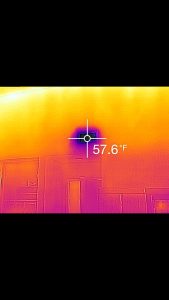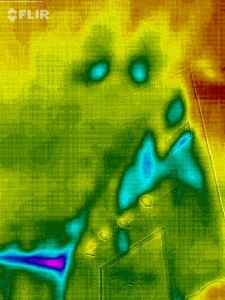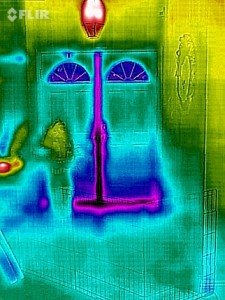Continuing the discussion on the Flir One infrared camera, I’d like to discuss the benefits as it relates to home maintanence and efficiency. If you have not read my Flir One/infrared overview, please see blog post: DIYers Must Have.
The Flir One has many home uses. Think about how many aspects of your house are related to or affected by temperature changes – the list is long.
Taking a picture with the Flir One camera is referred to as a scan.
Based on a scan of my air conditioning vent surface (remember it measures surface temp, not air temp) I can deduce that my air conditioner is running effectively. The temp scan of the vent opening was 57.6 degrees Fahrenheit (you can select F or C). The A/C thermostat showed a room temp of 76 deg for an air differential of 21.6 deg.

According to the Lowes website a 20 Deg differential means your A/C is working well. The Lowes article tells you how to test your a/c with a refrigerator thermometer for a lot cheaper, but hey where’s the fun in that. Plus how many uses does a refrigerator thermometer have?
Here is a synopsis of other uses limited only by your imagination.
Scans of your roof can show areas of missing or thinning insulation. Also, with the right conditions can show roof leaks.

This is a scan of our ceiling as you can see there are a few spots where the cold air is getting in (the blue tints). Further investigation is required to determine if it is just thinning insulation or a roof leak.
Scans around doors or external walls can show where heat (or cold) is escaping running up your utility bills.

This is a scan of my front door on a cold winter day. As you can see, cold is entering at the center and bottom of our door. Time to update some weather stripping.
A scan around a room can show heat sources like computers left on, tvs, etc.
A scan of your electrical panel can reveal if there are hot spots that may need to be looked at possibly preventing future fires.
Can’t tell where your sprinklers are hitting the grass, scan it and see where the damp (cooler) spots are.
Trying to track down a slab leak? The leak area should be cooler or hotter depending upon which line is leaking.
Having a hard time finding your studs? Wood studs will change temp different than your drywall so the scan will show your house’s skeleton.
One note, the scan is not accurate on glass or shiny surfaces so trying to see the temp difference between your window and wall is not straight forward. Try taping a section of your window with painters tape, wait a few minutes to let the tape temp adjust to the window temp, and scan the taped section.
The next Flir blog will address health uses. This is one you will not want to miss, so follow me to get notified of the posting.

